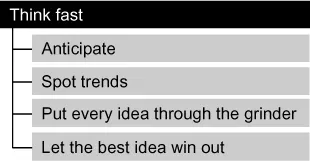
Summary: It's Not the Big That Eat the Small … It's the Fast That Eat the Slow
Review and Analysis of Jennings and Haughton's Book
BusinessNews Publishing
- English
- ePUB (handyfreundlich)
- Über iOS und Android verfügbar
Summary: It's Not the Big That Eat the Small … It's the Fast That Eat the Slow
Review and Analysis of Jennings and Haughton's Book
BusinessNews Publishing
Über dieses Buch
The must-read summary of Jason Jennings and Laurence Haughton's book: `It's Not the Big That Eat the Small...It's the Fast That Eat the Slow: How to Use Speed as a Competitive Tool in Business`.
This complete summary of the ideas from Jason Jennings and Laurence Haughton's book `It's Not the Big That Eat the Small...It's the Fast That Eat the Slow` shows that the modern business world uses speed as the main way to differentiate themselves from their competitors. However, the companies that get this right do not have some magic formula, they are simply strategic and self-aware enough to see the factors ahead that can slow them down. In their book, the authors suggest four key elements of speed as a competitive tool in business and take the reader through reaching each objective. This summary is a practical guide to saving time and money in order to get yourself noticed.
Added-value of this summary:
• Save time
• Understand key concepts
• Expand your skills
To learn more, read `It's Not the Big that Eat the Small...It's the Fast that Eat the Slow` and discover why speed is becoming the new competitive tool and why you need to master it or get left behind.
Häufig gestellte Fragen
Information
Summary of It’s Not The Big That Eat The Small … It’s The Fast That Eat The Slow (Jason Jennings and Laurence Haughton)
Section 1: Think Fast

Anticipate
- Study history to find what worked in the past in comparable or roughly equivalent circumstances and plan on the basis similar events will occur in the future.
- Look at all the opportunities that are closely linked to life cycles whenever new technologies have been released into the marketplace. Figure out what is likely to happen next as the new technology gets absorbed on the strength of what happened to other technologies.
- Consistently question every piece of conventional wisdom – ask why and how about everything. Refuse simply to accept conventional wisdom as being infallible.
- Increase the amount of time spent working on the business (planning and thinking) rather than in the business (actually producing your product or service).
- Become an expert in scenario planning – and use those skills to develop and build expertise in forward thinking. Don’t be so busy working you forget to stop and observe how the world is changing.
- Encourage everyone in the firm to become more empathetic to the needs of customers. That way, when consumer tastes change, you’ll be aware of it rather than surprised by it.
Spot trends
- Understand and watch for the key drivers of change:
- Customer-led – changes in the marketplace.
- Technology-led – new advances and breakthroughs.
- Capital-led – changes demanded by financiers.
- Government-led – new rules and regulations.
- Competitor-led – the actions of new market entrants.
- Have first-hand experience about everything you make decisions on. Specifically:
- Use the Internet to observe what’s going on.
- Read 20 - 30 magazines each month for ideas.
- Study the gay and other tight-knit communities.
- Listen to music, watch TV and travel.
- Study how people live and hang out with them.
- Look to customers to identify potential new and original product combinations and functional connections between disparate sets of products and services. You may be able to come up with some truly unique bundles.
- Develop a sense of taste and heightened perception – sensitivity about what pleases people and makes them happy. Observe and experience whatever makes your customers ecstatic and passionate.